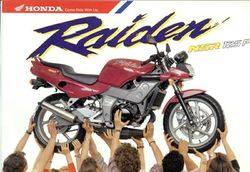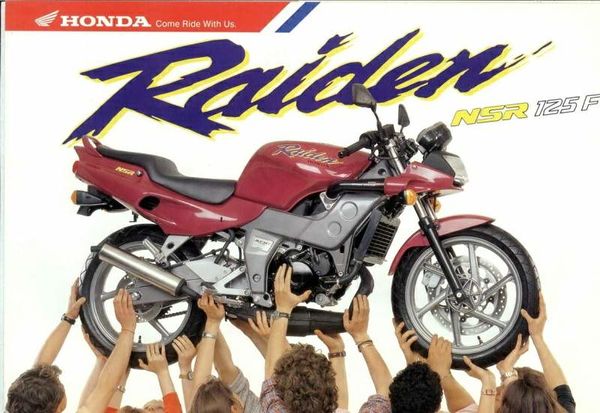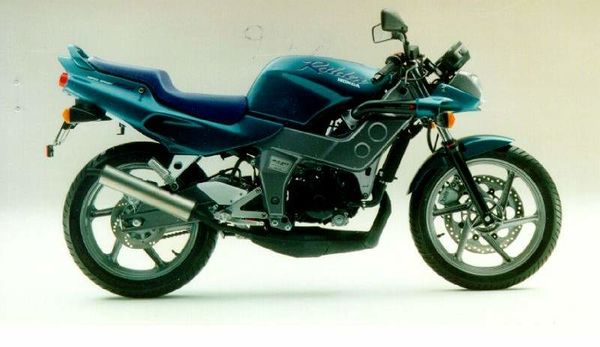Honda NSR125F Raiden
 |
|
| Honda NSR125F Raiden | |
| Manufacturer | |
|---|---|
| Production | 1992 - 93 |
| Engine | Two stroke, single cylinder, Reed valve induction |
| Compression ratio | 7.0:1 |
| Ignition | Capacitor discharge electronic ignition. |
| Transmission | 6 Speed |
| Frame | Double cradle tubular steel panels |
| Suspension | Front: 35mm Telescopic forks Rear: Pro-link rising rate adjustable preload. |
| Brakes | Front: Single 320mm disc 2 piston caliper Rear: Single 220mm disc 2 piston caliper |
| Front Tire | 110/80-17 |
| Rear Tire | 130/70-17 |
| Weight | 125 kg / 275.5 lbs (dry), |
| Recommended Oil | Honda GN4 10W-40 |
| Fuel Capacity | 13 Liters / 3.4 US gal |
| Manuals | Service Manual |
Engine[edit | edit source]
The engine was a Liquid cooled cooled Two stroke, single cylinder, Reed valve induction. The engine featured a 7.0:1 compression ratio.
Drive[edit | edit source]
Power was moderated via the Multi-disc oil bath.
Chassis[edit | edit source]
It came with a 110/80-17 front tire and a 130/70-17 rear tire. Stopping was achieved via Single 320mm disc 2 piston caliper in the front and a Single 220mm disc 2 piston caliper in the rear. The front suspension was a 35mm Telescopic forks while the rear was equipped with a Pro-link rising rate adjustable preload.. The NSR125F Raiden was fitted with a 13 Liters / 3.4 US gal fuel tank. The bike weighed just 125 kg / 275.5 lbs.
Photos[edit | edit source]
Overview[edit | edit source]
Honda NSR 125F Raiden
Model History (Translated) In the late eighties the performance of the 125 road (but also Enduro) had grown dramatically, touching and often exceeding the threshold of 30 CV, when only a few years before it came to fatigue to 15/20. It was the era in which young people dismantled the domes or even entire motorcycle fairings as , NS 125F Honda or Aprilia AF1, either out of necessity as a result of a slip or because those lines so sparse, the precursors of today's naked, at the time they were considered aggressive and more fashionable.
Honda at the end of 1987 did nothing but ride this trend by presenting a naked bike, the NSR 125F , which began to build in the factories of Atessa and market by May the following year. Characterized by the complete absence of any wind protection, leaving exposed the splendid Alcast frame aluminum, a revolution than the simple square tubes in the NS steel.
The front end was amazed to that lighthouse left uncovered; it seemed
that they had forgotten to mount a piece, but the bike was pleased because of
this. It was put on sale at 4,195,000 lire in two blue / black colors, the most
successful, and green / blue, both with alloy wheels orange three races. The
chassis was only the first of many innovations: the Alcast consisted of two half
shells made of aluminum alloy die-cast and fastened together in two crucial
points in the middle and at the steering tube; however behind the rear seat it
was in the most traditional system pipes steel frameworks.
Continuing with the chassis, the wheels were 17 "in front and 18"
inches behind, with tires respectively by 100 / 80e 130/70 and the front wheel
braking from a disc of 316 mm diameter with well Grimeca caliper. Obviously the
engine and its power, and exhaust system were fully redesigned since the vital
measurements of the thermal unit, which the NSR were square (actually slightly
sottoquadre), equal to 54 x 54.5 mm bore and stroke respectively, against
superquadre NS (56 x 50 mm). The power adopted a 28mm Dell'Orto PHBH carburetor,
while the NSR retired the ATAC valve replaced by
RC Valve
Electronically controlled controlled by an electric servo motor, a solution
which debuted for the first time on a production bike after being tested in the
races.
The claimed power output rising from 25 hp in the NS to
31 CV of NSR-F, provided at 10,500 rpm , with the RC valve is fully opened from 8,500 rpm. Its performance, including a top speed of over 160 km / h, despite the lack of fairing, won it a good debut also in the Italian Sport Production Championship. The following year, he adopted only two new colors but at the same time entered the market, at 5.18 million pounds, the version faired NSR 125R , presented just a year after the F, which also received a great success and above replaced the naked version in championship SP. In addition to the aesthetic differences such as the fairing with twin headlights, a more enveloping and cover the passenger seat front fender, R differed even for a different suspension settings, and the final report for a slightly longer, allowing her to check though more or less the same speed. The weight of fact in this case increased by 108 kg reported of F to 118 kg of the faired. For seasons '89 and 90 'Honda Italy readied also versions Sport Production, who had a 32 mm carburetor, an exhaust racing and adjustable shock absorber. Meanwhile, in 1990 the engine of the NSR, suitably detuned to 28 hp and with a redesigned exhaust, finished mounted on small enduro
CRM 125 , which winked aesthetics to more specialized CR motocross and replaced in the list MTX 125R presented in 85, which in turn mounted the engine of the 125F NS with two horses in less. Also in 1990 he came on the scene the NSR 125FII , which brought some changes, including the adoption of the system with air intakes AIS (Air Intake System) , the circles Grimeca six races and the thinner front fender, changes that affected also faired version. The following year there were no significant changes but the SP version entered in the price list no longer as special model sold only to pilots but affordable by all, at a price much higher than 6,648,000, but brought with it a motor modified (without electric starter), with carburetor Dell'Orto PHBH 28 as new regulation and Arrow exhaust, a different suspension settings and a braking system with floating disc. The maximum speed of the SP touched 170 times; in 1992 the SP underwent some changes and dressed with the new Rothmans livery. At the same time the third series of the NSR-F, renamed
Raiden , debuted in 1992 alongside the first and then replacing the previous one; same fate from '93 to R, which before the restyling adopted a livery inspired by the CBR 900RR Fireblade , presented that year. Both versions of the third series changed considerably appearance and technique: new such circles always Grimeca six races and both 17 ", but the changes were numerous, starting from the frame Zetaframe . although all tense and make the F longer a tourist naked, while the R had this time a fairing inspired by that of the and was also produced in SP version. The Raiden, sold at 5,585,000 lire, remained in production until the end of '94, while the faired R (6,300,000 lire in '93) until 2003, although since 2001 it was only available in limited version 8 kW (11 hp) due to the new regulations, the same that killed the field of 125 in the name of security, along with the anti-pollution standards on two-stroke engines, which decreed the extinction of the NSR and all the pepper that had made 125 dream of sixteen in the eighties and nineties. Source
| Make Model | Honda NSR 125F Raiden |
|---|---|
| Year | 1992 - 93 |
| Engine Type | Two stroke, single cylinder, Reed valve induction |
| Displacement | 124.7 cc / 7.6 cu-in |
| Bore X Stroke | 54 x 54.5 mm |
| Cooling System | Liquid cooled |
| Compression | 7.0:1 |
| Induction | 28mm Dell'Orto PHBH 26 FS |
| Ignition | Capacitor discharge electronic ignition. |
| Starting | Electric & kick |
| Max Power | 12 hp / 9 kW @ 9500 rpm |
| Max Torque | 15 Nm / 11 kb-ft @ 8000 rpm |
| Clutch | Multi-disc oil bath |
| Transmission | 6 Speed |
| Final Drive | Chain |
| Frame | Double cradle tubular steel panels |
| Front Suspension | 35mm Telescopic forks |
| Rear Suspension | Pro-link rising rate adjustable preload. |
| Front Brakes | Single 320mm disc 2 piston caliper |
| Rear Brakes | Single 220mm disc 2 piston caliper |
| Front Tire | 110/80-17 |
| Rear Tire | 130/70-17 |
| Dry Weight | 125 kg / 275.5 lbs |
| Fuel Capacity | 13 Liters / 3.4 US gal |
| Road Test | Motosprint 1992 |

